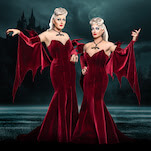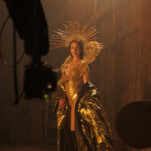The Met Gala proved that it's not Camp if you're trying

“Indeed the essence of Camp is its love of the unnatural: of artifice and exaggeration. And Camp is esoteric—something of a private code, a badge of identity even, among small urban cliques.” —Susan Sontag, Notes On “Camp”
Unlike many of the previous Met Gala themes, Camp is not a time, a place, a person, or an institution. It is a concept, one that often begins with an earnest effort and ends with a spectacular and beautiful failure. “I am strongly drawn to Camp,” Sontag wrote, “and almost as strongly offended by it.” How to dress in a way that walks that line was the puzzle of the evening. Usually balancing acts involve subtlety and compromise, but one can do neither with Camp. One should do neither. To do so would be to fail, and not in the glorious way that has resulted in so much of the best of Camp. But last night on the Met Gala’s pink carpet, we saw a fair amount of compromise.
When the announcement was made that the theme of this year’s exhibit, as well as the gala honoring its opening, would be centered on Susan Sontag’s seminal essay “Notes On ‘Camp’,” the news was met with excitement and wariness in equal measure by those in the fashion industry and media. In recent years, the looks worn to the gala have featured a few highs, a handful of lows, and a gathering in the middle of looks interested in only lightly referencing the theme of the night. Sometimes that middle settles on a color, like last year when the stairs that lead to the main entrance of the Metropolitan Museum Of Art were awash in relic gold, cardinal red, and Marian blue. Other years, like 2013’s affair celebrating the opening of Punk: From Chaos To Couture, it’s the hair and makeup that get thrown in our path to convince us that this isn’t simply a look one could have also worn to any number of summer movie premieres. In the years where a single designer is the focus, like 2017’s celebration of the innovative work of Rei Kawakubo or 2011’s tribute to the then recently deceased Alexander McQueen, a different problem arises. Not everyone wants to wear McQueen. Not everyone can wear McQueen. No other design house is McQueen.
Rihanna, who has spent recent years honoring the theme to the max, represents a high-water mark upon which we often judge the looks of all others in attendance, but we shouldn’t expect them to be her. Nor can they be Beyoncé or the woman orchestrating the night’s proceedings, Anna Wintour, who both hold enough power to do as they like year after year with only a passing care to follow what has been mandated for others.
Celebrities have their brands to craft or manage. Designers have the same, and it is often their dollars at stake. So if nothing superhero-esque plays well with your style or if the house with which you have signed a very lucrative contract deals in neutrals and would never consider a Schiaparelli pink, then there might not seem much to do but skirt the rules as best you can.
Pure Camp
“Many things in the world have not been named; and many things, even if they have been named, have never been described. One of these is the sensibility—unmistakably modern, a variant of sophistication but hardly identical with it—that goes by the cult name of ‘Camp.’”
To dress in a way that is tied up with failure takes verve and, as Sontag puts it, a type of naivete. It is a Camp that, for lack of a less cliché way to put it, comes from the heart and possibly from the soul. One might look to the Wachowski sisters’ Jupiter Ascending, a film where planets are farmed for human lives, the main villain lives on Jupiter, and bees are able to detect whether one has royal blood, as a recent example. The film is big and too much and a wolf-man zooms around on rocket boots, but it is not joking. It is serious throughout and would not be a perfect example of Pure Camp, as Sontag terms it, if everyone involved had seen the project as anything but that.
























































































